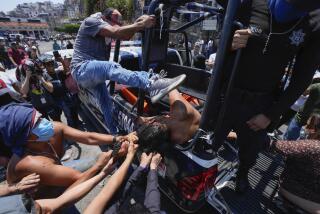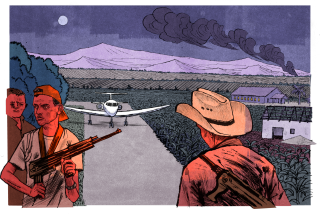Enrique’s Journey | Chapter Two: Notes About Sources
Experiences in Las Anonas: written from interviews with Sirenio Gomez Fuentes; Mayor Carlos Carrasco; Carrasco’s mother, Lesbia Sibaja; San Pedro Tapanatepec Mayor Adan Diaz Ruiz; resident Beatriz Carrasco Gomez; and other villagers. Nazario visited the Gomez home, the Las Anonas church and the mango tree where Enrique collapsed.
Enrique’s requests to Gomez for water and pants: from Gomez and Enrique.
Exchange between Mayor Carrasco and Enrique about whether he fell from the train: from Carrasco and Enrique. Carrasco’s shout to his mother: from Carrasco and his mother.
Questions Gloria Luis asks Enrique: from Luis. Enrique recalled that one of the townspeople asked these questions. His response that he was going to find his mother: from Enrique, confirmed by Luis and Mayor Carrasco.
Comments by Mayor Diaz criticizing Central American immigrants and their governments: from Mayor Carrasco, confirmed by Diaz. Diaz’s debate with himself about helping Enrique: from Diaz, corroborated by Carrasco, who said Diaz voiced some of these concerns to him. Statement by Diaz to Enrique that he would help him: from Enrique, confirmed by Diaz and Carrasco.
Enrique’s remark to Ricardo Diaz Aguilar, the mayor’s driver, that he thought he would die: from the driver, confirmed by Enrique.
Ride to the doctor and encounter with the judicial police officer who Enrique says robbed him: from interviews with Enrique and Ricardo Diaz Aguilar, who took him to the clinic. Manuel de Jesus Molina, who in 2000 served as assistant to the mayor of Ixtepec, a nearby town, says Enrique’s experience with the judicial police was common in the area. The denial that judicial police rob people is from Sixto Juarez, chief of the Agencia Federal de Investigacion in Arriaga, Mexico.
First six attempts: from interviews with Enrique and from Nazario’s observations of other immigrants along the same route. She visited the spot near Medias Aguas where Enrique was stung by bees. She went to the Tapachula cemetery and the mausoleum where Enrique slept. Cemetery caretaker Miguel Angel Perez Hernandez and Mario Campos Gutierrez, a supervisory agent with the government migrant rights group Grupo Beta Sur, provided information about recent violence in the graveyard. The annual number of deportees from Mexico is from the National Migration Institute of Mexico.
Beating on the train: from interviews with Enrique and residents of Las Anonas and San Pedro Tapanatepec. Robberies in which immigrants are stripped and hurled from trains are commonplace, according to: rights group Grupo Beta Sur, whose officers occasionally patrol the trains; Father Flor Maria Rigoni, a Catholic priest at the Albergue Belen migrant shelter in Tapachula, Chiapas state; Baltasar Soriano Peraza, a caseworker at the shelter; and other immigrants who have been robbed on the trains by street gangsters. Railroad personnel and Mayor Carrasco estimated how fast the trains travel in the area.
Enrique’s plea to gangsters: from Enrique, who recalled his words six weeks later. Suggestion by a gangster that Enrique be thrown off the train: from Enrique. His prayer that he be spared so he could see his mother again and his worry over how his family would know his fate: from Enrique.
Medical condition and treatment: from interviews with Enrique and Dr. Guillermo Toledo Montes, who treated him. Mayor Diaz provided the doctor’s receipt detailing Enrique’s treatment. Nazario visited the clinic and the police command post where Enrique slept. Words spoken between Enrique and Toledo: from the doctor and Enrique.
Money from sympathetic strangers in San Pedro Tapanatepec: from Enrique.
Exchange between Enrique and the driver he flagged down for a ride: from Enrique. Statement from immigration agents telling Enrique he couldn’t keep going north: from Enrique.
The bus ride to Guatemala: from interviews with Enrique; immigrants on the bus; and Nazario’s observations riding the bus to El Carmen, Guatemala, where the trip ends. How street gangsters rob riders is from Baltasar Soriano Peraza, the caseworker at the Albergue Belen shelter; Mexican immigration agent Fernando Armento Juan, who accompanies migrants on the bus; and migrants, including Carlos Sandoval, a Salvadoran, who said he was accosted by gangsters with ice picks.
More to Read
Start your day right
Sign up for Essential California for news, features and recommendations from the L.A. Times and beyond in your inbox six days a week.
You may occasionally receive promotional content from the Los Angeles Times.






